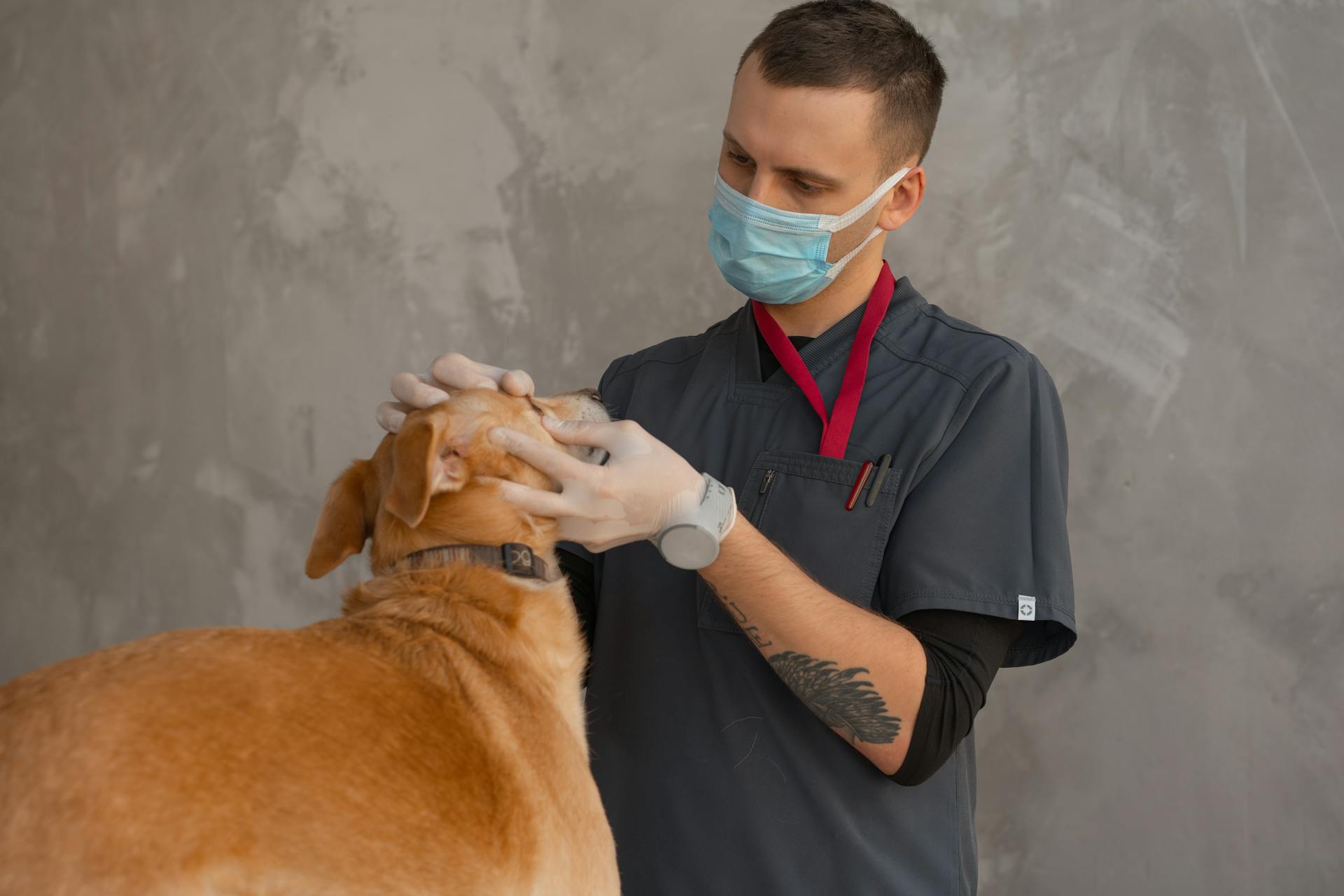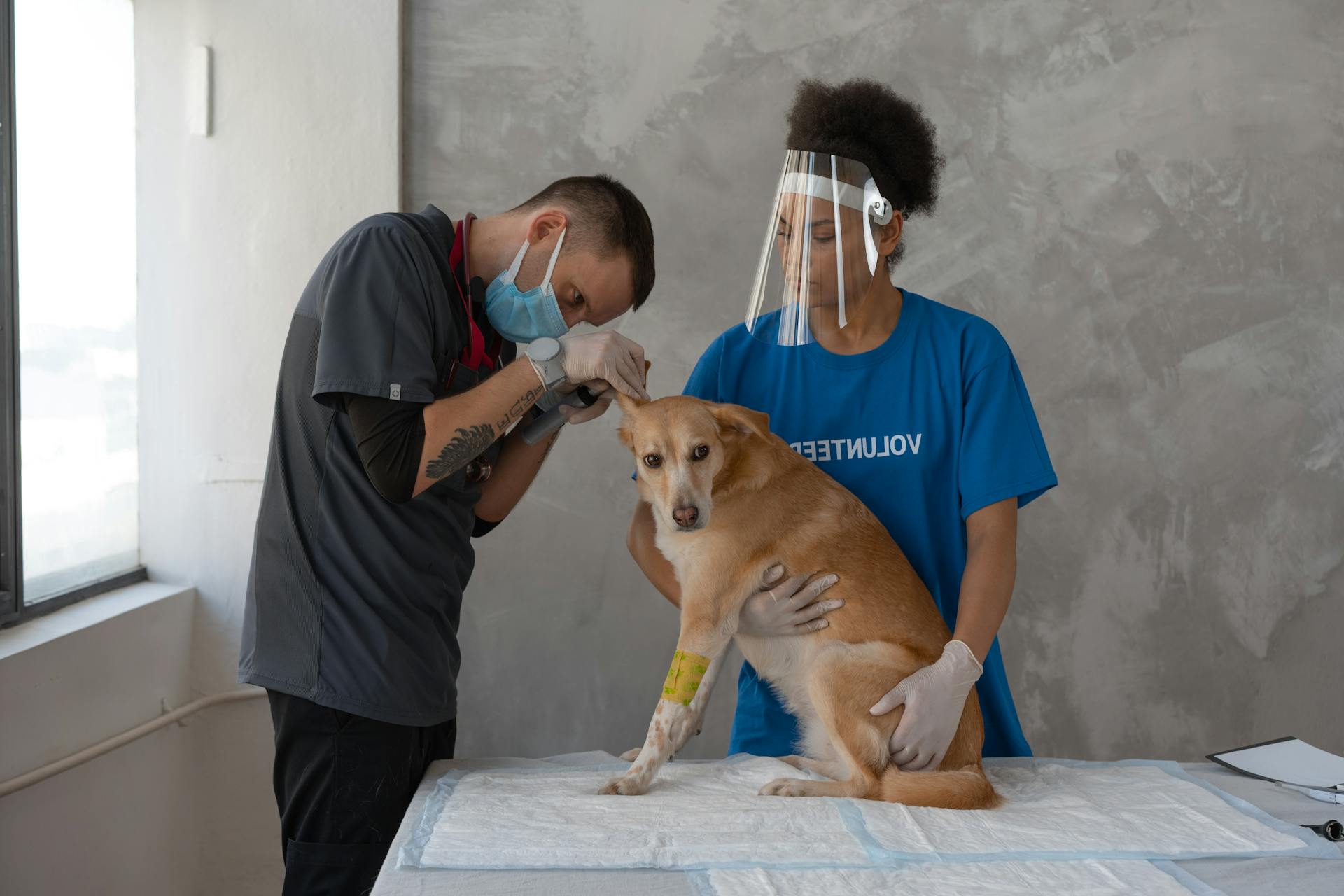
Lymphoma in dogs is a type of cancer that affects the immune system, and it's more common in certain breeds such as Basset Hounds, Bulldogs, and Boxers.
The survival rate for dogs with lymphoma varies depending on the type and stage of the disease, but it's generally around 50% with chemotherapy treatment.
Early detection and treatment are key to improving a dog's chances of survival, with some dogs living up to 2 years or more with proper care.
Chemotherapy is often the primary treatment for lymphoma in dogs, and it can be effective in reducing tumor size and improving quality of life.
Suggestion: Canine Liver Cancer Treatment
What Is Lymphoma in Dogs?
Lymphoma is a cancer that affects the lymphatic system, including the lymph nodes, spleen, and lymphatic vessels. This cancer can be localized or spread throughout the body.
Lymphoma in dogs targets lymphocytes, a type of white blood cell that plays a key role in the immune response. Similar to humans, dogs have lymphocytes concentrated in organs like the lymph nodes, spleen, and bone marrow.
Dogs can develop lymphoma in various organs, including the skin, eyes, kidney, lung, or nervous system, which is known as extranodal lymphoma. This type of lymphoma is rare but can have significant effects on the affected organ.
Veterinarians use similar chemotherapy protocols to treat lymphoma in dogs as human doctors do for non-Hodgkin's lymphoma. This similarity in treatment highlights the shared characteristics between canine and human lymphoma.
Changes in lymphocyte levels can affect organs like the lymph nodes, spleen, and bone marrow, leading to lymphoma. This overgrowth of lymphocytes can occur in various organs, making lymphoma a complex and multifaceted disease.
Types of Lymphoma in Dogs
There are over 30 types of lymphoma in dogs, each with its own unique characteristics. Dogs can get lymphoma, a type of cancer that affects the immune system, and it's not always easy to diagnose due to varying symptoms.
Multicentric lymphoma is the most common type, accounting for around 80-85% of cases. It affects the lymph nodes, which are located in various parts of the body, such as the neck, chest, armpits, and groin.
The symptoms of multicentric lymphoma can be subtle at first, but as the disease progresses, dogs may develop lethargy, fever, anorexia, weakness, and dehydration. Enlarged lymph nodes are a common sign, feeling like firm, rubbery lumps that move freely beneath the skin.
Alimentary lymphoma, also known as gastrointestinal lymphoma, is the second most common type, making up less than 10% of cases. It affects the digestive system, which can cause a range of symptoms, including vomiting, diarrhea, and weight loss.
Mediastinal lymphoma is a rare type that affects the chest area, causing a lump or fluid buildup that can make it hard for dogs to breathe. Extranodal lymphoma affects specific organs or sets of organs, such as the skin, eyes, kidneys, lungs, or central nervous system.
Here are the four most common types of lymphoma in dogs:
- Multicentric lymphoma
- Alimentary lymphoma
- Mediastinal lymphoma
- Extranodal lymphoma
Symptoms and Diagnosis
Symptoms of lymphoma in dogs can vary, but common signs include one or more firm, enlarged lymph nodes on the body, reduced appetite, feeling tired, weight loss, and swelling in the face or legs.
Enlarged lymph nodes can appear in areas like under the neck or jaw, behind the knees, in front of the shoulders, or in the armpits. They're not painful, but if you notice lumps like these on your dog, ask your vet to check them.
Reduced appetite, feeling tired, and weight loss are often mild symptoms, but they can progress to more severe symptoms like vomiting, diarrhea, and trouble breathing. Dogs with cutaneous lymphoma have red, itchy, dry, and flaky patches of skin.
Here's a breakdown of the stages of lymphoma:
A biopsy is the most accurate way to diagnose lymphoma, and it involves removing a sample of a dog's lymph nodes or organs.
What Causes?
Lymphoma in dogs is a complex issue, and experts still aren't sure what causes it. Researchers think genetics and conditions outside and inside our homes play a role.
Dogs are exposed to many things that may cause cancer, such as weed killer. Scientists also have looked into other possible causes, including viruses and bacteria.

Lymphoma accounts for approximately 7% to 24% of cancers in dogs. Since dogs share our environment, they're exposed to many of the same environmental factors that may cause cancer in humans.
One study found that there was an increased risk of lymphoma in 30 dog breeds and a reduced risk in 26 breeds. Results suggested that male dogs were more likely to develop lymphoma than female dogs.
Spayed or neutered dogs of both sexes were at a higher risk for lymphoma, compared to intact dogs. This is something to consider if you're thinking of spaying or neutering your dog.
Recommended read: Dog Breeds Watch Dogs
Signs and Symptoms
As you're trying to figure out if your dog has lymphoma, it's essential to know the common signs and symptoms. Some dogs may not seem sick at all, while others may have mild symptoms like feeling tired and not wanting to eat.
One of the most noticeable signs is the appearance of firm, enlarged lymph nodes on your dog's body. These can show up in various places, such as under the neck or jaw, behind the knees, in front of the shoulders, and in the armpits.
You might enjoy: What Are the Final Stages of Lymphoma in Dogs

Dogs with lymphoma may also exhibit a range of other symptoms, including reduced appetite, feeling tired, weight loss, swelling in the face or legs, increased thirst, more frequent peeing, diarrhea, throwing up, and trouble breathing.
Here are some of the specific symptoms you might notice:
- Reduced appetite
- Feeling tired
- Weight loss
- Swelling in the face or legs
- Increased thirst
- More frequent peeing
- Diarrhea
- Throwing up
- Trouble breathing
Lymphoma can also cause skin symptoms, such as red, itchy, dry, and flaky patches of skin, which can become thick and moist with open sores over time.
Diagnosis
Diagnosis is a crucial step in determining the extent of lymphoma in dogs. Your veterinarian may suspect cancer after observing an enlarged lymph node.
A fine-needle aspiration is the most common diagnostic tool, which extracts a sample of a dog's lymph nodes or organs. This sample is then evaluated through a cytology exam or biopsy.
The biopsy process may involve a minor surgery to remove a larger piece of a lymph node or other organ. The sample will be tested for cancer, and the results will help determine the stage of the disease.

The stage of lymphoma is important for treatment and prognosis. There are five stages: Stage I involves a single lymph node, Stage II affects multiple lymph nodes in one region, Stage III affects all lymph nodes, Stage IV involves lymph nodes and organs such as the liver, spleen, or chest, and Stage V involves the bone marrow.
Here is a breakdown of the stages:
Some veterinarians may also recommend staging tests, such as blood tests, urinalysis, X-rays, abdominal sonograms, and bone marrow aspiration, to determine how far the disease has progressed.
Treatment and Prognosis
Chemotherapy is the most effective treatment for lymphoma in dogs, with some dogs living up to 9 to 12 months with proper treatment.
The type of chemotherapy used will depend on the type of lymphoma your dog has, and your vet may recommend a combination of chemo drugs.
Dogs often receive weekly chemo treatments for several months, and some may experience side effects like vomiting, diarrhea, and decreased appetite.
Readers also liked: Natural Cures for Lymphoma in Dogs
However, most dogs tolerate chemotherapy well and don't lose their hair or get severely sick.
The CHOP protocol, used to treat lymphomas in humans, is sometimes used to treat dogs with multicentric lymphoma.
If your dog doesn't respond to chemotherapy, your vet may try treatments to reverse drug resistance.
Radiation therapy and surgery may also be recommended by your vet, especially for low-grade localized lymphoma.
Monitoring your dog's health closely is crucial, especially after treatment, as lymphoma can recur.
The prognosis for lymphoma varies depending on the type and stage of the cancer, but most dogs who receive chemotherapy experience remission.
Unfortunately, many dogs will relapse at some point, and the cancer may become more resistant to treatment.
Despite this, some dogs can achieve second remissions, and with proper care, they can live for over a year.
The average survival time for untreated dogs is 60 days, but with chemotherapy, it can be extended to 9 to 12 months.
Your vet can provide more specific information on your dog's prognosis if you pursue additional testing to characterize the lymphoma better.
With proper treatment, many dogs can live a relatively normal life, and with close monitoring, you can help your dog manage the disease.
A fresh viewpoint: T-cell Lymphoma in Dogs
Living with Lymphoma in Dogs
Lymphoma in dogs is a complex disease with many different factors that can impact your dog's health.
Most dogs who get chemotherapy for lymphoma go into remission, with some experiencing total remission, meaning all symptoms of the disease have disappeared.
The disease often comes back, though, and your vet may call this a "relapse." Treatment helps some dogs get back into remission, but when the cancer returns, it may be harder to treat.
Lymphoma cells become resistant to chemotherapy over time, making treatment less effective.
Keep in touch with your vet while your dog gets lymphoma treatment or recovers from it to learn what to expect if the disease gets worse and how to keep your pet as happy and comfortable as possible.
You can also ask your vet about hospice care and euthanasia if the lymphoma can no longer be treated.
Dogs with lymphoma can live for many months in remission, but the disease will eventually likely be fatal.
If an initial remission is achieved with treatment, dogs will often live at least a year before the disease returns.
Sequential remissions are often shorter and the lymphoma is more resistant to further treatment.
Expand your knowledge: Treatment for Hemangiosarcoma in Dogs
Frequently Asked Questions
When should you euthanize a dog with lymphoma?
When a dog's lymphoma is causing severe pain or discomfort that cannot be managed with treatment, it may be time to consider euthanasia. Consult with your veterinarian to determine the best course of action for your dog's specific condition
Has a dog ever survived lymphoma?
Yes, some dogs have survived lymphoma, although the typical survival time with chemotherapy is 10-12 months, with less than 25% living for two years.
Is lymphoma a fast growing cancer in dogs?
Lymphoma in dogs can progress rapidly in some cases, but its growth rate varies greatly depending on the type. Some forms of canine lymphoma are life-threatening without treatment, while others progress slowly and can be managed as chronic diseases.
How fast does B-cell lymphoma spread in dogs?
Untreated B-cell lymphoma in dogs typically progresses rapidly, with most dogs succumbing to the disease within 1-2 months. Treatment can temporarily slow its spread, but prompt action is crucial for optimal outcomes
How quickly do dogs with lymphoma deteriorate?
Dogs with untreated lymphoma or on steroids for palliative care typically deteriorate rapidly, with a life expectancy of approximately two months. Their condition can progress quickly, making timely veterinary care and treatment crucial.
Featured Images: pexels.com


